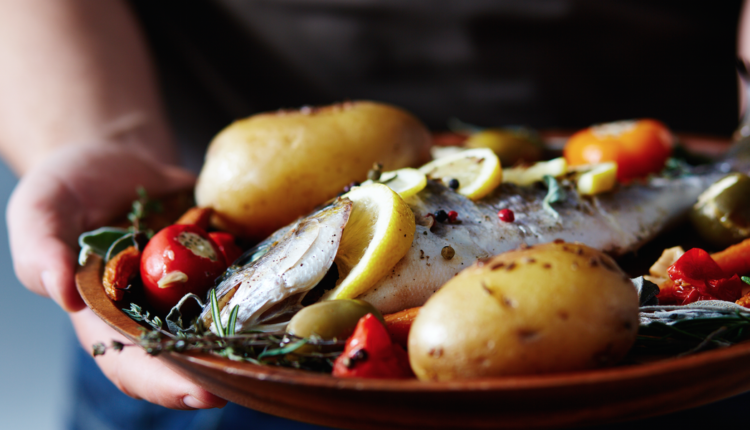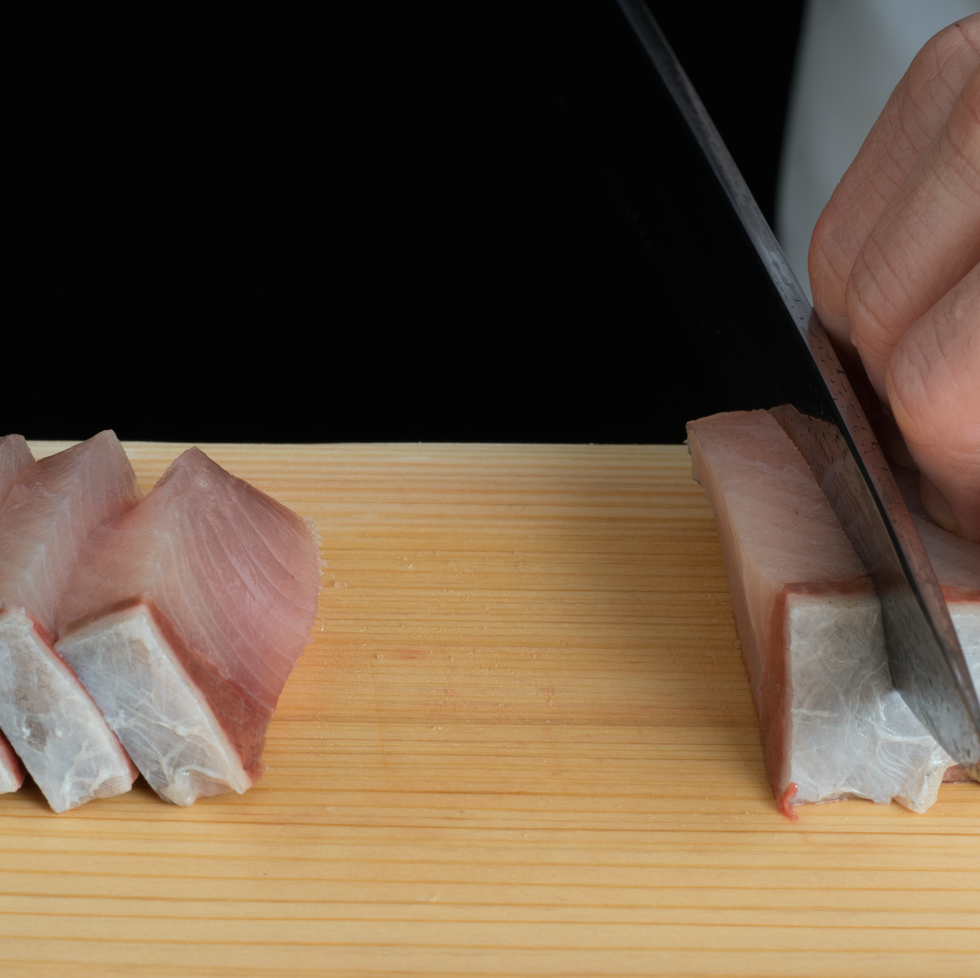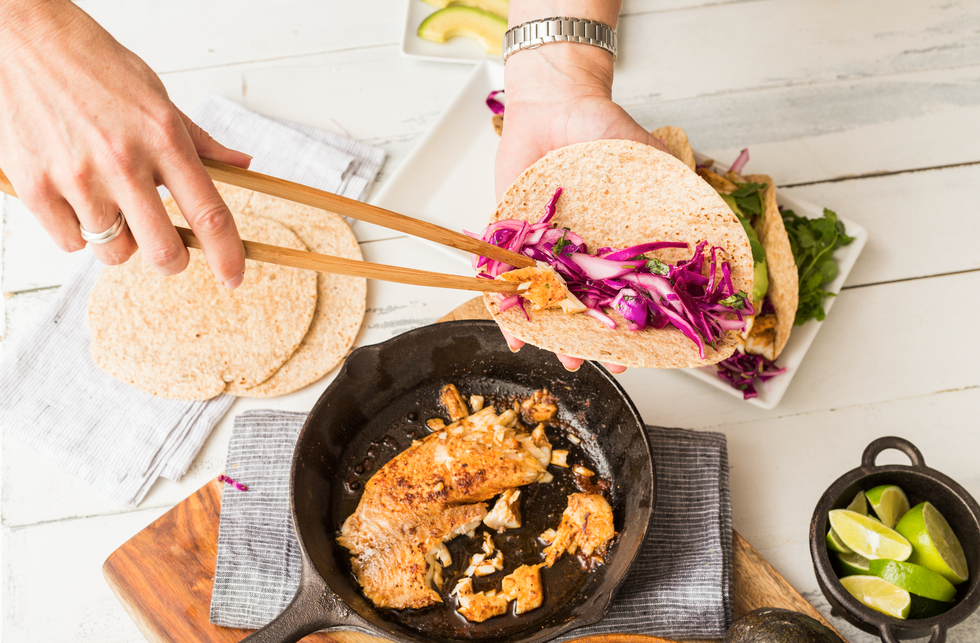EMBRACING A DIET rich in fish can unlock a world of health advantages that shouldn’t be underestimated. That’s especially true if you’re trying to increase your protein intake.
“According to national dietary survey data, the average intake of seafood falls about half of recommended intake amounts for American adults,” says Meghan Pendleton, R.D.
Recommendations for fish intake vary depending on what organization statements you look at, but generally, adults are recommended to consume at least two servings of fish per week as main protein sources, and also for other benefits that fish can offer. However, the average American relies largely on chicken, beef, and pork to fulfill protein recommendations. This is, in part, because of accessibility and affordability, but fish is still generally overlooked, says Ally Rosen, R.D., C.P.T.
If you’re not a vegetarian or vegan, sea creatures are likely well worth loading up on more often. “Fish not only offers tons of lean protein, but most fish are high in heart-healthy fats like omega-3s and are also rich in essential minerals like calcium, phosphorus, iron, zinc, iodine, and magnesium,” says Rosen.
Plus, if you’re aiming for weight loss, fish is one of the best low-calorie proteins. Find out below why fish should have a spot on your shopping list, as well as a few high protein options.
Why Is Fish A Good Protein Option?
There are more reasons to eat fish than simply for its impressive protein content (and delicious taste). “Fish, especially options like salmon, trout, mackerel, and cod, are excellent protein choices due to their omega-3 fatty acid content,” says Rosen. Omega-3s have been shown to reduce inflammation, improve heart health and circulation, and even improve cognitive function.
Omega-3 fatty acids play a particularly important role in our health. They help form cell membrane structure, create signaling molecules that our brain needs to communicate with the rest of the body, and work in many body systems including the body’s cardiovascular, neurological, and endocrine systems, Pendleton says. “Omega-3 fatty acids have long been associated with anti-inflammatory properties. Several decades of observational research have consistently shown that higher fish intakes are associated with a reduction in risk of conditions such as heart attacks, strokes, and all-cause mortality.”
There’s another star vitamin found in some fish, too. Salmon, tuna, mackerel, and trout, are all good sources of vitamin D as well as protein, says Pendleton. Nearly 42 percent of the U.S. population is deficient in vitamin D, since it’s only found in sunlight and a small amount of foods.
Another benefit of fish? Its versatility, says Rosen, who sees many clients in her practice that tell her they are bored with chicken. Fish is a protein you can always change up. “Season them in new ways, and even try out different cooking methods. Fish is great baked, grilled, pan-seared, etc.,” she says.
How Much Protein Should I Eat in A Day?
Before we determine the best fish to eat for protein, it’s always good to know exactly how much protein you should be aiming for.
“Factors like age, activity level, and health conditions influence protein needs,” emphasizes Penleton. If we look at the U.S. Dietary Guidelines, a sedentary adult is set at 0.8 grams of protein per kilogram of bodyweight.
But, it should be noted that these guidelines are levels of nutrients thought to be sufficient to meet nutrition needs. “Sufficient does not mean optimal,” she says. Nutrition experts agree that intake should be higher in order to maximally stimulate muscle protein synthesis (creation of new muscle tissue), especially for those with higher needs (athletes, older adults, those on a weight maintenance plan, some chronic diseases, etc.).
Somewhere around 1.0 to 1.2 grams of protein per kilogram of bodyweight is a more ideal goal, says Pendleton. It’s important for someone to work with a dietitian to figure out the best amount for you based on your unique health history.
Hitting that protein goal becomes even more important as we age as there’s a increasing risks of diseases like osteoporosis and arthritis. Adequate protein intake will aid in maintaining muscle mass, which will protect us from these kinds of diseases, says Pendleton.
This list ranks the highest-protein fish, according to the USDA Nutrient Database. Shop, cook, and eat accordingly. No lemon pepper seasoning needed.
Yellowtail
One four-ounce filet of this slightly oily fish has a potent 34 grams of protein for 212 calories. How does that compare to chicken breast? The same amount (4 oz) has 26 grams of protein and 110 calories.
Sure, you’re saving like 100 calories, but yellowtail tastes amazing. Broil it, top it with flaky sea salt and freshly squeezed lemon juice. Great sushi bar order too.
Tuna (light, canned in oil)
Yeah, tuna fish!
Four ounces contain 33 grams of protein and 225 calories. And don’t work yourself up into a panic about the mercury in tuna fish. The FDA recently issued this statement: “Five of the most commonly eaten fish that are low in mercury are shrimp, canned light tuna, salmon, pollock, and catfish.”
Anchovy (canned in oil)
So four ounces has 52 grams of protein for 378. THAT SAID, you’re definitely not going to eat four ounces unless you want to back out of a date or something. But anchovies are very high in two things: omega-3s and flavor.
You could pop them on a pizza, but they’re even better in pasta sauce, where they heighten the flavors of everything else instead of overpowering the dish. Mix two anchovy fillets into your next batch homemade sauce when you add your garlic and onions.
Coho Salmon
This low-calorie, high-omega-3 wild fish houses 31 grams of protein for only 209 calories. Its flavor is intensely fresh and almost sweet, so don’t do anything to ruin it. It’s great right off the grill with lemon juice, salt, and a little chopped dill.
Trout
Anglers love it; fish counters don’t always carry it. But when you see trout (or catch it), savor it. The flesh is supremely tender and takes well to a trip to the smoker. A four-ounce fillet will have 30 grams of protein for only 215 calories.
Snapper
You may see red snapper at your grocery store, but all varieties share a similar nutritional profile: 30 grams of protein and 145 calories for every four ounces. It’s a firmer-flesh fish, so it a great option to grill, and its hearty flavor matches well with oil-and-herb-based sauces.
Tilapia
What tilapia lacks in flavor, it makes up for in an amazing protein-to-calorie ratio. In one fillet, you’ll find 23 grams of protein for only 111 calories.
In the taste department, try marinating this fish and then cooking it in a hot cast-iron pan. When it’s flaky, it’s perfect for fish tacos.
Bluefish
Not to be confused with bluefin tuna, raw bluefish is more of light purple than a deep red. Cook the meaty flesh and it turns white and flaky. You may have had it smoked, but it’s also great quickly pan-fried. Four ounces contains 29 grams of protein and 180 calories.
Pollock
Not the abstract painter. The member of the cod family. It’s flaky. It’s neutral tasting—which is while you’ll often find it inside fish sticks. But it’s also a fast-cooking fish that works well inside a burrito. At 28 grams of protein and 134 for four ounces, it’s a solid nutritional pick.
Grouper
This fish won’t take first prize at a beauty pageant any time soon, but at 28 grams of protein and 134 calories per four ounce serving, it’s a nutritional winner. Try it pan-seared with blackening spices or Cajun seasoning.
Sardines (canned in oil)
Stop turning your nose up at this omega-3 loaded fish. Consume a four ounce serving and you’ll take in 28 grams of protein for 236 calories. Pop some on some Triscuits and call it a snack.
Catfish
One fillet has an impressive 24 grams of protein for 189 calories, which is, like, nothing. Treat it like any other whitefish: broil it, roast it, grill it, pan-sear it.
Flounder
Another whitefish, like catfish. One fillet has 20 grams of protein and even fewer calories than catfish—114. Ditto on the cooking tips.
Mackerel
Mackerel is another impressive fish, clocking 20 grams for protein for 1 fillet. It is higher on the calorie side than the white fish, but it’s still relatively low at 230 calories. Try this one pan-fried or baked.

Paul is the Food & Nutrition Editor of Men’s Health. He’s also the author of two cookbooks: Guy Gourmet and A Man, A Pan, A Plan.
Perri is a New York City-born and -based writer; she holds a bachelor’s in psychology from Columbia University and is also a culinary school graduate of the plant-based Natural Gourmet Institute, which is now the Natural Gourmet Center at the Institute of Culinary Education. Her work has appeared in the New York Post, Men’s Journal, Rolling Stone, Oprah Daily, Insider.com, Architectural Digest, Southern Living, and more. She’s probably seen Dave Matthews Band in your hometown, and she’ll never turn down a bloody mary. Learn more at VeganWhenSober.com.






Comments are closed.